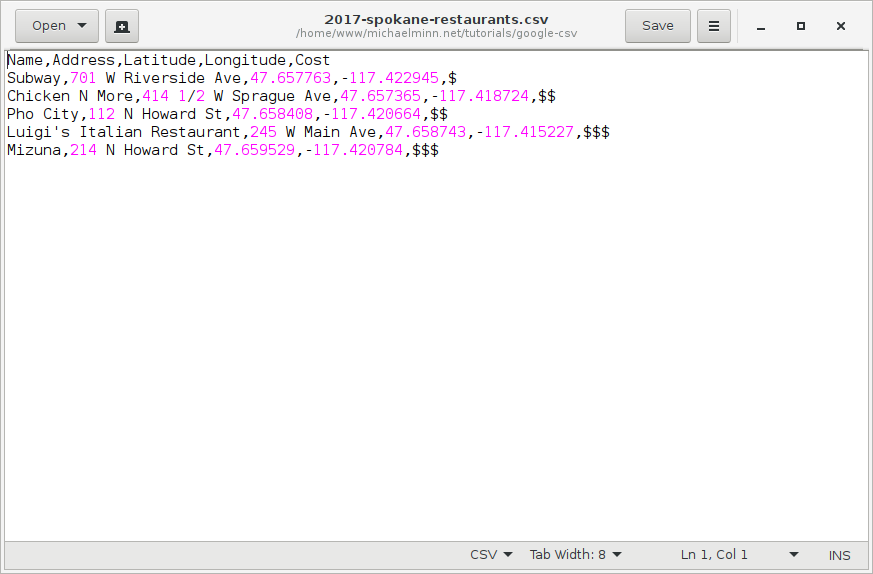Google Maps Placemarks From Spreadsheets
While placemarks can be directly drawn onto a Google Map, when there are a large number of placemarks, or you are creating placemarks from a table of data, it may be easier to import the placemarks into Google Maps from a spreadsheet.
To start a new Google Map for customization:
- Go to drive.google.com and log into Google Drive using your gmail account login. If you do not have a Google account, you can create one for free
- To create a new map, click the New button, More, and Google My Maps
- If Google My Maps does not appear as an option, select Connect More Apps and search for Google My Maps
- You may want to give the map a meaningful Name when you create the map so you don't forget to name it later
Point Spreadsheets
Spreadsheets of placemark points can be prepared with a desktop application like Micro$oft Excel, or in Google Sheets.
The example below is for a handful of restaurants in downtown Spokane, WA.
Regardless of which path you take, your spreadsheet should be arranged with column names (also called field names or attribute names) on the very top row, with subsequent rows representing individual placemarks.
To map points, two of your columns should be the latitude and longitude for each point.
If you find a location you wish to map in Google Maps, you can get the latitude and longitude by right-clicking on the location, selecting What's Here, clicking the displayed latitude and longitude, and copying the latitude and longitude from the side palen.
Be sure to copy the latitude and longitude in decimal format (example: 47.656884, -117.427090) rather than the degrees-minutes-seconds format (example: 47°39'31.5"N 117°24'54.8"W), which is an older method of describing latitude and longitude that cannot be read by most mapping software.
Also be sure to include the negative sign if one is present on the longitude value. Longitudes in North America are west of the Prime Meridian, so they are negative. If you omit the negative sign, your positive longitude will probably be somewhere in Asia.
Comma-Separated Variable (CSV) Files
If you create your spreadsheet with a desktop spreadsheet program like Micro$oft Excel, you will need to export that spreadsheet to a comma-separated variable (CSV) file.
A CSV file is exactly what is says it is. If you open a CSV file in a text editor, you will see rows of variables separated by commas:

In a new map, click Import to add the CSV placemarks to a layer.
If you named your columns latitude and longitude, Choose columns to position your placemarks should find them.
Choose a column to title your markers.
Google Sheets
If you are creating a spreadsheet from scratch, it may be easier to just create it in Google Sheets. A Google spreadsheet can be imported directly into Google Maps, and since the spreadsheet is kept in Google Drive, you don't have to worry about forgetting where you put it.
Styling Placemarks
You can style placemarks individually by selecting the style icon in a placemark or in the side panel.
If you have a categorical variable, you can also style categories if icons the same way by selecting Individual styles, Style by data column Group places by
If your placemarks are not too densely clustered, you might also want to Set labels to place labels beside the placemarks.
Base Map
It is possible to change the base map, which is a map placed under a thematic map to give geographic context to the features.
In this case, the information on the default base map makes the map a bit cluttered, and the light political or mono city base maps make the features stand out a bit more clearly.
Sharing
Finally, you should set the sharing for the map.
Click the Share link, change who has access, and select Public on the web.
Get a link to the map from the Link to Share box at the top of the sharing dialogue. You can then share the map by texting or e-mailing this link.
If you want to embed this map in a web page, you can get HTML iframe code by clicking on the top ellipsis and selecting Embed on my site.
KML Export and Import
You can also save the contents of a map to a Keyhole Markup Language (KML) file.
A KML file allows you to import maps into Google Earth or desktop GIS programs like ArcMap. KML files also allow you to save files as documents, which you can then use to easily recreate old maps.
You export to a KML file by clicking on the ellipses at the top of the map and selecting Export to KML/KMZ.
To create a new map from a KML file, start a new map from Google Drive and Import the KML file into a layer.
Reopening
Google Maps automatically saves changes as you make them, so when you are done with your map, you can just close the window.
If you want to re-open the map later, you can just double-click on it in Google Drive.